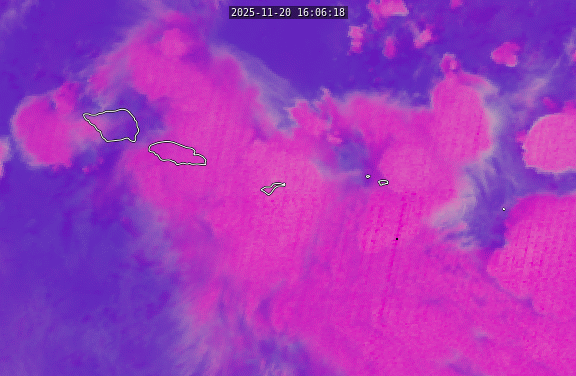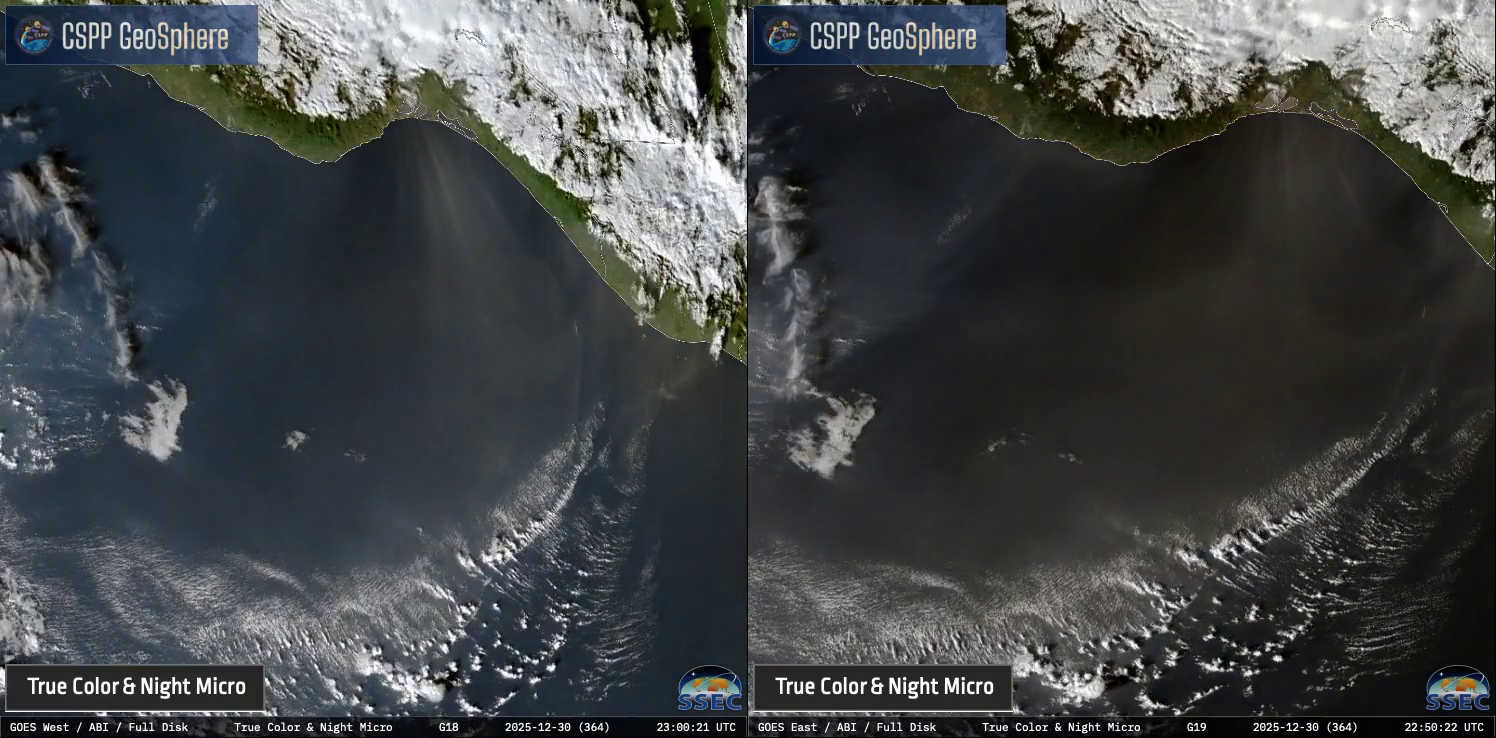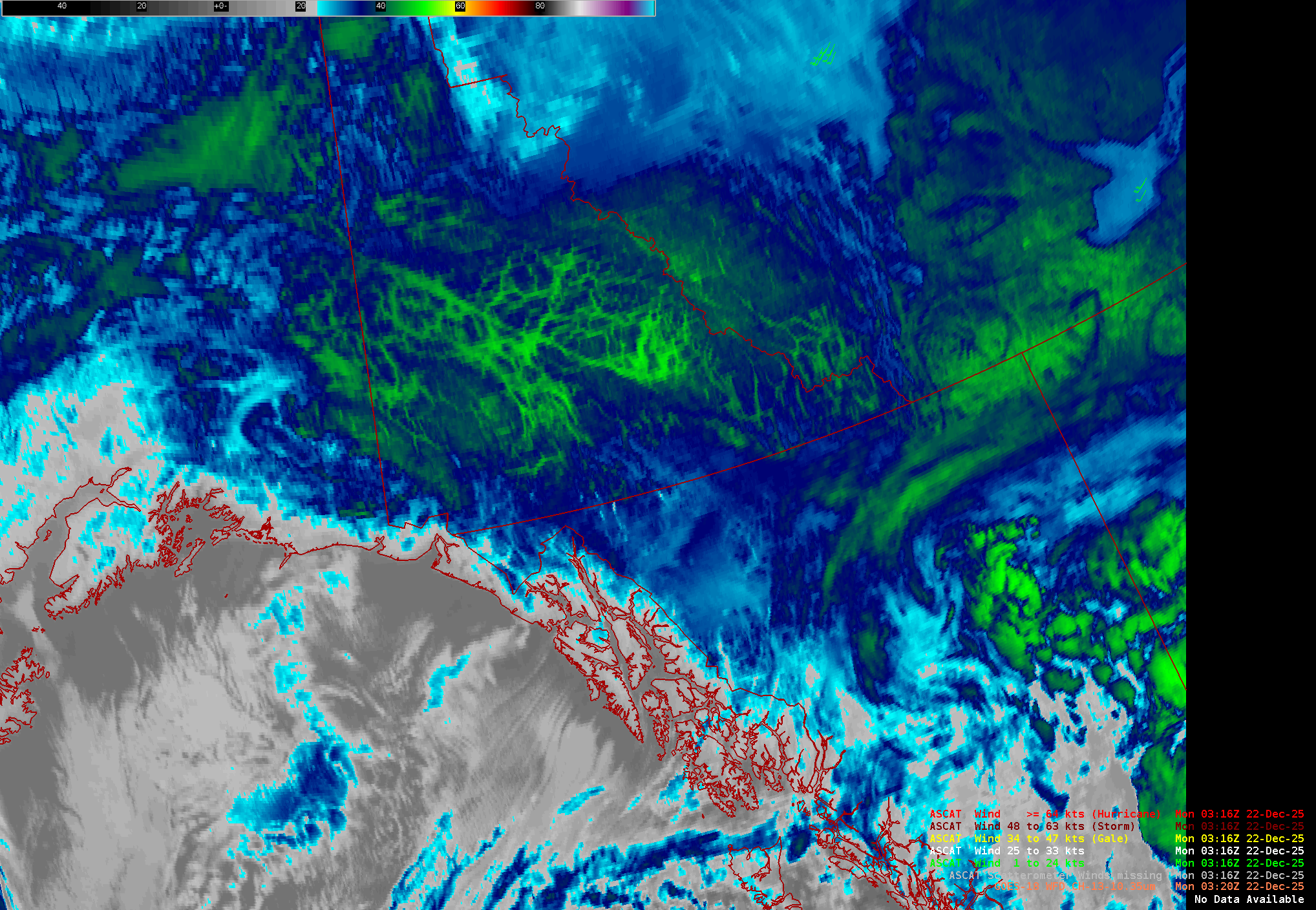Continuing in the tradition of a blog post looking back on some of the most noteworthy events of the year as seen by GOES, here is a summary of 2025 CIMSS Satellite Blog posts. In previous years, a selection of several GOES ABI loops during 2022 and 2023 and 2024 showcased the diverse range of features observed, including, but not limited to, volcanic activity, tropical cyclones, severe convection, fog, smoke, fires, blowing dust, flooding and ice.
The goal here is to show a variety of phenomena and locations that NOAA‘s GOES ABI routinely monitors. Just one highlight per month (most months, sometimes it’s hard to choose just one) and we’re covering a lot of types of events, some of which were tragic, deadly, and/or costly. Most loops generated are from the University of Wisconsin-Madison CIMSS Satellite Blog, and the original blog posts are linked if you’re interested in reading more on any of these cases. Imagery from GOES-16, -18, and -19 are showcased, along with the ABI‘s three different scan sectors: Full Disk (10-min intervals), Contiguous U.S. (5-min intervals) and Mesoscale Sectors (typically 1-min intervals). The GOES-R Series has more than an Imager instrument on it though, and we’ll include some Solar Ultraviolet Imager (SUVI) and Geostationary Lightning Mapper (GLM) data as well.
First we can celebrate 2025 with some Full Disk animations from GOES-East using the CIMSS Natural True Color RGB. We will start with the sunset view from GOES-East, from Winter Solstice 2024 (Dec 21, 2024) to Winter Solstice 2025 (Dec 21, 2025). Winter Solstice in the northern hemisphere is when the north pole reaches its maximum tilt away from the sun. Sunset for GOES-East (at the location on Earth directly below the satellite, roughly at the equator and 75W) is around 23 UTC. The exact time of sunset varies somewhat through the year, but we just chose the nominal 2300 UTC image for each day to make things simpler. And a handful of days are missing, because of bad data.
Next is satellite noon in CIMSS Natural True Color RGB from GOES-East for all of 2025 (minus a handful of days with bad data). Noon for GOES-East is around 1700 UTC.
January
The two highlighted events for January are wildfires in/around Los Angeles and snow across the Deep South. The LA wildfires caused damages estimated to be around $300 billion, with at least 31 deaths attributed directly to fire. There were multiple CIMSS Satellite Blog entries, not all GOES-centric, discussing this event: Palisades Fire (Jan 7), NGFS detections of multiple fires in/near Los Angeles County (Jan 8), Day Night Band imagery of fires over California (Jan 9), Landsat-9 images of the Palisades Fire and Eaton Fire burn scars in Los Angeles County, California (Jan 14), and later in January the Hughes Fire near LA (Jan 22). Shown below is an animation of the first four days of the Los Angeles area wildfires using the ABI Fire Temperature RGB, from January 7th-10th:
This historic snowstorm across the Deep South left 8 (EIGHT!) inches of snow (official measurement at the airport) in New Orleans, Louisiana.
February
February saw South Dakota’s first February tornado on record on February 24. This animation features both GOES-16 ABI and Geostationary Lightning Mapper (GLM) data.
March
A strong solar flare captured by GOES-16 SUVI occurred on March 28th:
April
GOES-19 became operational as GOES-East on April 7:
There were several blowing dust events in April — perhaps the most impressive as seen from GOES was the blowing dust behind a cold front moving across New Mexico, Texas and Mexico on April 19th:
May
Speaking of blowing dust, on May 16th, 2025 blowing dust prompted the issuance of the first Dust Storm Warning on record for the Chicago metro area:
June
In recent years we have seen more interest in the media as some part of the United States sees air quality impacts from wildfire smoke coming from Canada, and 2025 was no exception. One example from June 11th was Canadian wildfire smoke over Alaska:
July
Unfortunately July 4th this year was marked with one of the deadliest flash-flooding events in US history, and the deadliest of this century. Catastrophic flash flooding event in the Hill Country of Texas responsible for at least 130 fatalities:
August
On August 16, 2025 Hurricane Erin became the earliest Category 5 hurricane on record in the Atlantic Ocean as it was north of the Leeward Islands:
September
There was a lunar eclipse on September 7th. Not for us on Earth, just for GOES, when the moon temporarily blocked the view of the sun from both GOES-East and -West. Effects of a lunar eclipse on GOES-18/GOES-19 SUVI imagery:
October
This year we celebrated the 50th Anniversary of the launch of GOES-1 on October 16th, 1975 with this special look at a GOES animation from each of all 50 states: Fifty Loops for the 50th Anniversary of GOES

On October 28, Hurricane Melissa made landfall on Jamaica as a devastating Category 5 hurricane.

November
In addition to being the 50th anniversary of the launch of GOES-1, 2025 was also the 50th anniversary of the sinking of the Edmund Fitzgerald. This is one of the most well-remembered weather-related disasters in US history, and we take a fresh look at this storm from November 10th, 1975 with modern reanalysis data and modern tools. We don’t have any GOES imagery of this storm in our possession, but we have the next best thing: Synchronous Meteorological Satellite (SMS)-2. The SMS series was an experimental series of satellites that NASA launched and operated until SMS-C became GOES-1. SMS-1, -2 and GOES-1 through -4 are all the same design.

With the two operational GOES, we can see over half the surface of the earth, from the west coast of the African continent to the east coast of Australia, and not quite to the north and south poles. American forecasters have responsibility across a large portion of that area, and to highlight that here is a case from November 20th of flash flooding in American Samoa — where they don’t have a radar, so satellite observations are critical. (Incidentally, there were a least 4 times in 2025 when a 1-minute Mesoscale Sector was positioned over American Samoa to monitor flash flooding.)

December
For the last month of the year we will highlight two events. Both of these events have gone on longer than maybe one would want or expect. There was been a long-duration Tule fog event in the Central Valley of California that started on November 21st and continued for over a month. Meanwhile Mt Kilauea in Hawaii has been erupting since December 23 of last year!

Thank You!
To close out 2025, we would like to say thank you to all of our readers! The author would like to say a special thank you to the authors of the blog posts that he borrowed imagery from today: Scott Bachmeier, Scott Lindstrom, Tim Schmit, and Tim Wagner. Thanks to all who make the GOES imagery possible, the ingest and software to display the imagery (including, but not limited to McIDAS-X, Geo2Grid, GeoSphere, RealEarth and AWIPS). Special thanks to Dave Stettner of the UW/CIMSS AWG Imagery Team.
Special note: Scott Lindstrom has retired from UW-Madison and we will miss him, especially here on the Blog!
Looking for more satellite blogs? Check out the Satellite Liaison Blog.
View only this post Read Less




















